Joseph Conrad and His Novel

Polish-British author Joseph Conrad was born Jozef Tedor Konrad Korzeniowski on December 3, 1857 in Berdychiv, Russian Empire as it was called then. He would come to England and apply for British Citizenship on July 2, 1866. Among the other life experiences which entered his writings was being a Merchant Marine. At the age of 36 Conrad gave up the sea and became a writer of short stories, essays on topics of the day and novels.
In 1899 "Blackwood's Magazine" published a three part novella by Conrad. The title was "Heart of Darkness". The American Publishing Company known as the "Modern Library" lists the novella 67th in the 100 Best Novels of the 20th Century. Many others consider this ranking accurate.
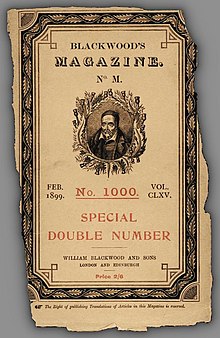
The novel opens on the Merchant Ship the "Nellie", anchored near Gravesend, England, on the River Thames. There Merchant Seaman "Charles Marlowe" tells his fellow seamen the story of how he became appointed the Captain of a River Steamboat for an Ivory Trading Company and what followed.
Below is a picture of the actual River Steamboat the "Rio des Belges (King of the Belgians)". That Joseph Conrad was its Captain during 1889. This took place in the Belgium Congo and is the type of Steamboat "Marlowe" is speaking about. The novella was based upon Joseph Conrad's own experiences during this period.

In his novella Joseph Conrad has "Charles Marlowe" speaks of blank spaces, unexplored or non-European settled, on the map of Africa at the time. He refers to one within the Belgium Congo as:
a place of darknessWhere most White's had never gone and he would enter to take a job for a trading company. Traveling along a big river, the Congo (?), the name is never mentioned in the novella, but is described by Conrad as:
resembling an immense snake uncoiled, with its head in the sea, its body at rest curving afar over a vast country and its tail lost in the depths of the landAgain referring to the same map of Africa. "Marlowe" tells his fellow sailors the feelings he was experiencing. As he took that trip to Africa aboard a French Passenger Ship. Saying that:
instead of going to the centre of a continent I were about to set off for the centre of the earthAfter 30 days at sea, from France, the ship anchors on the Coast of Africa. At the seat of the French Government located at the mouth of that big river. Which will shortly take him into the "Heart of Darkness" on a small steamboat, owned by a Swede. "Charles Marlowe" now travels another 30 miles from civilization to the Trading Company's initial Station.
Below a picture of such a station in the 1899 Congo.
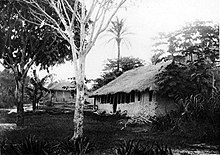
Next "Marlowe" spends 10 days at the Company Station where he is told of a "Mr. Kurtz" by the Company's "Impeccably Dressed" accountant. Who seems out of place in his clothing fit for Paris, but not the Jungle. Through the accountant's words Conrad describes "Kurtz" as a:
very remarkable person
Sends in as much ivory as all the others put together
He will be a somebody in the Administration before long. They, above—the Council in Europe, you know—mean him to beNext "Charles Marlowe" begins a journey, with 60 other men, of 200 miles on foot to the Company's Central Station. Where is is to take command of a steamboat. After the 15 day track and upon arrival at the station. "Marlowe" is told his steamboat was mysteriously wrecked just two days before his arrival.
Additionally things are even worse for "Marlowe". He is told the company manager couldn't wait for his arrival and sent another boat upriver, because "Mr. Kurtz" appears to be seriously ill. At this point in the story "Charles Marlowe" has also become sick. That is stick and tired of hearing about the ""Great Mr. Kurtz".
"Marlowe" gets help taking the wrecked boat out of the river. Then he starts repairing it by himself that will take several months. The station's brick layer befriends "Charles Marlowe" and at one point invites him into his room. Once again "Marlowe" can not escape the spirit of "Mr. Kurtz". There is a painting on the bricklayers rooms wall of a women,draped and blind folded. She is carrying a torch that gives the oil painting a sinister look to it. "Marlowe" is told it was painted by "Kurtz". Whom the bricklayer now describes as:
a prodigy, an emissary of pity, and science, and progressThen says he feels that "Mr. Kurtz" is a man of:
higher intelligence, wide sympathies, a singleness of purposeWhich is needed for the CAUSE Europe entrusts the company to do. As he believes "Marlowe" is also.
Finally with his steamboat is repaired. "Charles Marlowe", a small crew and some European passengers set forth. He stops at an abandoned hut finding a pile of cut wood. A note informs him that the wood is for his boiler and that he must proceed as fast as possible to the Inner Station of "Mr. Kurtz", but a warning is given to take caution.
As the steamboat travels upriver a fog engulfs it and a loud scream followed by a lot other noises is heard, but made by who? A few hours later "Marlowe's" steamboat is attacked as small arrows fly out of the dense forest, but nobody is seen by those on board. Suddenly a spear impales itself in the helmsmen's body. "Charles Marlowe" starts sounding the steamboats whistle and the shower of arrows stops and all is quiet,
It is at this point in the story that Conrad uses a flash forward having "Charles Marlowe" think of a report written by Kurtz for the "International Society for the Suppression of Savage Customs". At the end of his report "Mr. Kurtz" had added a postscript:
Exterminate all the brutes!Back to the on going story the steamboat arrives at "Kurtz's" Inner Station and the heavily armed European passengers disembark. "Charles Marlowe" notices a man waiving his hands at him and approaches. The man identifies himself as a Russian Wanderer who entered the camp some time back. He informs "Marlowe" that "Mr. Kurtz" is extremely ill and weak.
Through this conversation "Charles Marlowe" learns the local natives worship "Mr. Kurtz". That the Russian admires "Kurtz's" intellect, his insights into love, life and justice and even believes "Mr. Kurtz" to be a poet. The Russian adds he admires "" for his power and use of it. "Charles Marlowe" responds by saying it sounds to him as if "Mr. Kurtz" has gone mad.
By that night "Charles Marlowe" has yet to meet "Mr. Kurtz", but notices, from his steamboat, near one end of the station a row of posts. On each post is the severed head of a native. From around the corner come some of his European passengers and the Russian. On a stretcher is "Kurtz" who is brought on board the steamboat and put in a cabin. Later the company manager comes out of the cabin and informs "Marlowe" that "Mr. Kurtz" has harmed the company business in this region and his methods are considered unsound. Later the Russian tells "Charles Marlowe" that he has heard the company wants to kill "Mr. Kurtz".
On the return trip down the river "Kurtz's" health worsens and "Charles Marlowe". The steamboat breaks down and while being repaired "Marlowe" is given some papers by "Kurtz"/ These include his report to the "International Society for the Suppression of Savage Customs. "Mr. Kurtz's" condition becomes very critical and just before her dies "Marlowe" hears him whisper:
THE HORROR! THE HORROR!"Charles Marlowe" returns to "Civilized Society", but refuses to turn over "Kurtz's" papers to those who ask for them. Finally he gives the papers to a journalist to decide if he wants to actually publish them. "Marlowe" visits Kurtz;s fiancee who has wanted to see him. She asks what were "Kurtz's" final words and "Marlowe" lies. Telling the women that it was her name.

Above is a photo of Leon Rom. Who many believe was the inspiration for Joseph Conrad's "Mr. Kurtz". It has been argued that the two met in the Belgium Congo in 1898 the year before "Heart of Darkness" was published.
Leon Auguste Theophile Rom was born April 2, 1859 in Mons, Belgium. He joined the Belgian Army at the age of 16 and worked as a Customs Official until leaving for the new "Congo Free State". Which was ruled by King Leopold II. Who ruled as the second King of the Belgian's from 1865 to 1909 and founded the "Congo Free State".
Rom commanded the station at "Stanley Falls (Boyama Falls) and received a series of rapid promotions. Below an actual photograph of "Stanley Falls" taken at about the time Rom was commanding the Belgium Station.

Eventually, Leon Rom, became the District Commissioner of Matadi. Which is the chief sea port of the present day "Democratic Republic of the Congo". Below is an actual photo of Matadi at the time of District Commissioner Rom.

Leon Rom was praised by King Leopold for taking an Arab strong hold during the "Congo Arab War" of 1892 to 1894. However, there is another side to Leon Rom that has writers believing he was the model for Joseph Conrad's "Mr. Kurtz".
Rom became famous throughout the "Congo Free State" and Europe for his alleged brutality in the "Stanley Falls" area. According to contemporary reports from white missionaries. Leon Rom used the severed heads of 21 Congolese natives to decorate his flower garden. Also according to these reports. Rom had a permanent gallows set up. According to historians the displaying of severed heads was not considered out of the ordinary in White Central African Society.
Rom died peacefully in Brussels, Belgium on January 30, 1924.
On June 27, 2016 the movie "The Legend of Tarzan" was released and the villain of the piece was "Captain Leon Rom". Here is a link to a description of the character on the website Villains Wiki:
http://villains.wikia.com/wiki/L%C3%A9on_Rom
Francis Ford Coppola and His Movie

I LOVE THE SMELL OF NAPALM IN THE MORNING!I don't, but that was because I made it during the Vietnam War. However, my experiences are not what this article is about.
Francis Ford Coppola was born in the "Motor City", Detroit, Michigan in 1939. His first stint in motion pictures was for Roger Corman writing the English dialogue for a 1959 Russian Science Fiction movie "Nebo zovyot (The Sky Calls)". Which was turned into Roger Corman's 1962 "Battle Beyond the Sun". Also that year Coppola co-wrote and co-directed "The Bellboy and the Playgirls" starring Jayne Mansfield. Mamie Van Doran wannabe June Wilkinson. Noted for her measurements of 43-22-37 on a 5 foot 6 inch frame.
The following year Coppola assisted in both writing and directing portions of Roger Corman's "The Terror" starring Boris Karloff and an unknown Jack Nicholson. However, the feature that Corman turned the young movie maker loose on was 1963's "Dementia 13". Which was about a family with an axe-welding murderer. Three years later, in 1966, Francis Ford Coppola had moved up in the motion picture world. He wrote the screenplay for the Natalie Wood, Robert Redford movie "This Property is Condemned". Along with being one of the screenplay writers on the major World War 2 film "Is Paris Burning". Followed by the motion picture comedy "You're A Big Boy Now", which he also directed, starring Elizabeth Hartman, Geraldine Page and Rip Torn.
Thirteen years later in 1979. Francis Ford Coppola, Produced and Directed a motion picture he had Co-written the screenplay with John Milius entitled "Apocalypse Now". Coppola had moved Joseph Conrad's "Heart of Darkness" from the Belgium Congo to neutral Cambodia during the Vietnam War. The motion picture was originally released May 10, 1979 at the Cannes Film Festival with a running time of 153 minutes.

The three main characters of Conrad's novel were changed this way.
"Charles Marlowe" was no longer a one time Merchant Marine sailor, but was now "Captain Benjamin L. Willard". An Army Special Operations Officer assigned to Vietnam/Cambodia
"Mr. Kurtz" was now "Colonel Walter E. Kurtz". A highly decorated U.S. Army Special Forces Officer.
The Russian now becomes an American Photo Journalist. Who was a discipline of "Kurtz".
The U.S. Army has determined that "Colonel Kurtz", portrayed by Marlon Brando, has gone mad. He now commands his personal army made up of Montagard's who are also known as Dejar's. Although the story takes place in Cambodia. The Montagard's are the indigenous people of the Central Highlands of Vietnam. The word Montagard means "People of the Mountains". To the Montagard's "Colonel Kurtz" is a demi-god.
Here Francis Ford Coppola goes back to his origins. The officer in charge is "Lieutenant General Corman" of Military Intelligence portrayed by G.D. Spradin. The reference to Roger Corman is obvious.

His aide has a double reference. He is "Colonel Lucas", referring to George Lucas, and to make the reference really hit the audience. Coppola cast Harrison Ford in the role.

"Captain Benjamin L. Willard", portrayed by Martin Sheen, is given the assignment:
To Terminate Kurtz With Extreme Prejudice!
"Willard", who has mixed feelings about this mission, hops a ride on a United States Navy River Patrol Boat (PBR) that's going up river. "Captain Willard's" journey into the "Heart of Darkness" has started.
The crew of the Navy Patrol Boat are interesting characters. They reflect the young men who were mainly drafted into it. Although you were not drafted into the Navy. You volunteered and many did to beat going to the ground war in Vietnam. However, as with this Patrol Boat's crew. Sometimes you didn't avoid the war zone.
Engineman 3rd Class "Jay 'Chief' Hicks" was portrayed by Frederic Forest. "Chief" is described as a tightly wound former Chef from a New Orleans restaurant. Who is against the war.

Albert Hall portrayed Navy Chief Petty Officer "George Phillips". "Phillips" clashes often with "Willard" over who is really in charge of the mission on his boat.

Sam Bottoms portrayed Ginner's Mate 3rd Class "Lance B. Johnson". "Lance" is a former Professional California Surfer who is taking LSD in an attempt to keep the war out of his head.

Lawrence Fishburne portrayed Gunners Mate 3rd Class "Tyrone 'Mr. Clean' Miller". The 17 year old 'cocky' South Bronx-born crew member.

As the Patrol Boat heads up river, as in Joseph Conrad's novel, the crew and "Willard", like the passengers and "Marlowe", have different experiences. Some good and some bad.
The first is meeting surfing enthusiast Colonel "William 'Bill' Kilgore". Robert Duvall. Who loves that smell Napalm gives off when dropped. "Kilgore" is in command of the 1st Squadron, 9th Air Cavalry Regiment. One of the absurdities of the war comes out after Colonel "Kilgore" discovers who "Lance" is and he offers to escort them over a Viet Cong held coastal mouth of the river.
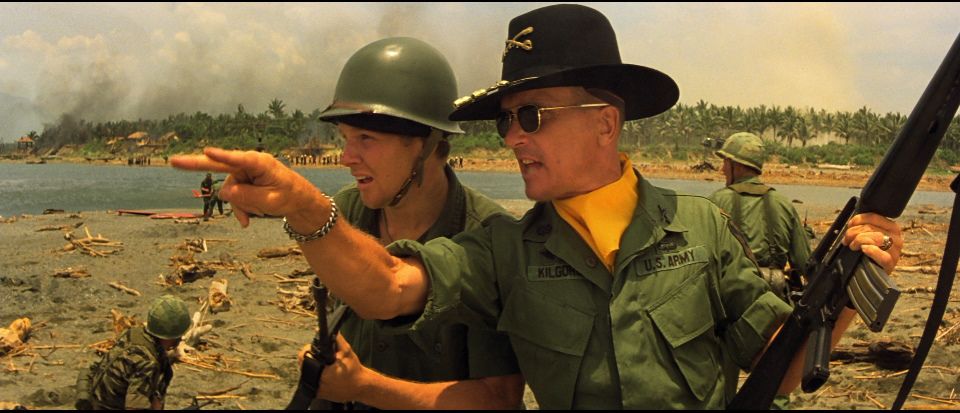
Above as the war ranges around them. "Kilgore" points out to "Lance" the fine surfing conditions of the river. The Patrol Boat had been attached to one of the 9th Air Cavalry's helicopters and "Captain Willard" and the boat's crew rode along in an attack, with Napalm drops, on the Viet Cong. As "Colonel Kilgore" blasts out German composer Richard Wagner's "The Ride of the Valkyries" on loud speakers.

Another seeming weird occurrence to those who were not in the war, but true. Happens with the arrival of "Playboy Bunnies" to entertain the troops in the middle of the jungle as "Captain Willard" and the crew of the Navy Patrol Boat are continuing up river. They stop to enjoy the show until a Viet Cong attack begins and the bunnies are flown away in their helicopters.



"Willard" learns that another operative "Captain Richard M. Colby", portrayed by Scott Glenn, had been sent up river on the same mission as his own. He defected to "Kurtz's" private army, but sent a letter to his wife that was intercepted giving "Willard's" superiors the information they withheld from him until he was at a point of no return. Along with this new information the Boat Crew receives letters from home.
As they start back up river "Lance" accidentally activates a smoke grenade and the Patrol Boat is spotted by a hidden Viet Cong marksman. "Mr. Clean" is killed, Further up river some of "Kurtz's" natives attacks and a spear impales "Chief Phillips" killing him. The native than goes after "Willard" who manages to kill him. "Captain Willard" tells "Chef" that he will continue up river alone, but "Chef" says that along with "Lance". The three of them will finish the mission together. They arrive at "Kurtz's" fortress compound.



Above standing in the center with the Green Beret is Scott Glenn.

"Captain Willard" also meets the unnamed Photojournalist portrayed by Dennis Hopper. Accorduing the extra's on the original DVD release. The character was based on American Photojournalist Sean Flynn, son of Errol, who disappeared in Cambodia during the Vietnam War.

Below Sean Flynn in Cambodia.

"Willard" and the other two wander around the compound and then return to the Patrol Boat. "Chef" is told to call in an air strike on the location, if "Captain Willard" and "Lance" do not return to the boat within three hours.
However, "Willard" is captured by "Kurtz's" men, "Chef" is killed attempting to call in the air strike, but "Lance" is left free.
"Captain Willard" is brought before "Colonel Kurtz". The "Colonel" is a demi-god to the natives and the soldiers he leads. "Kurtz" lectures "Willard" on his theories of war and the human condition/

After this lecturing "Captain Willard" is taken by "Kurtz's" men and tortured into what they believe is his submission. After several days in captivity within a cage. "Willard" is given his freedom.
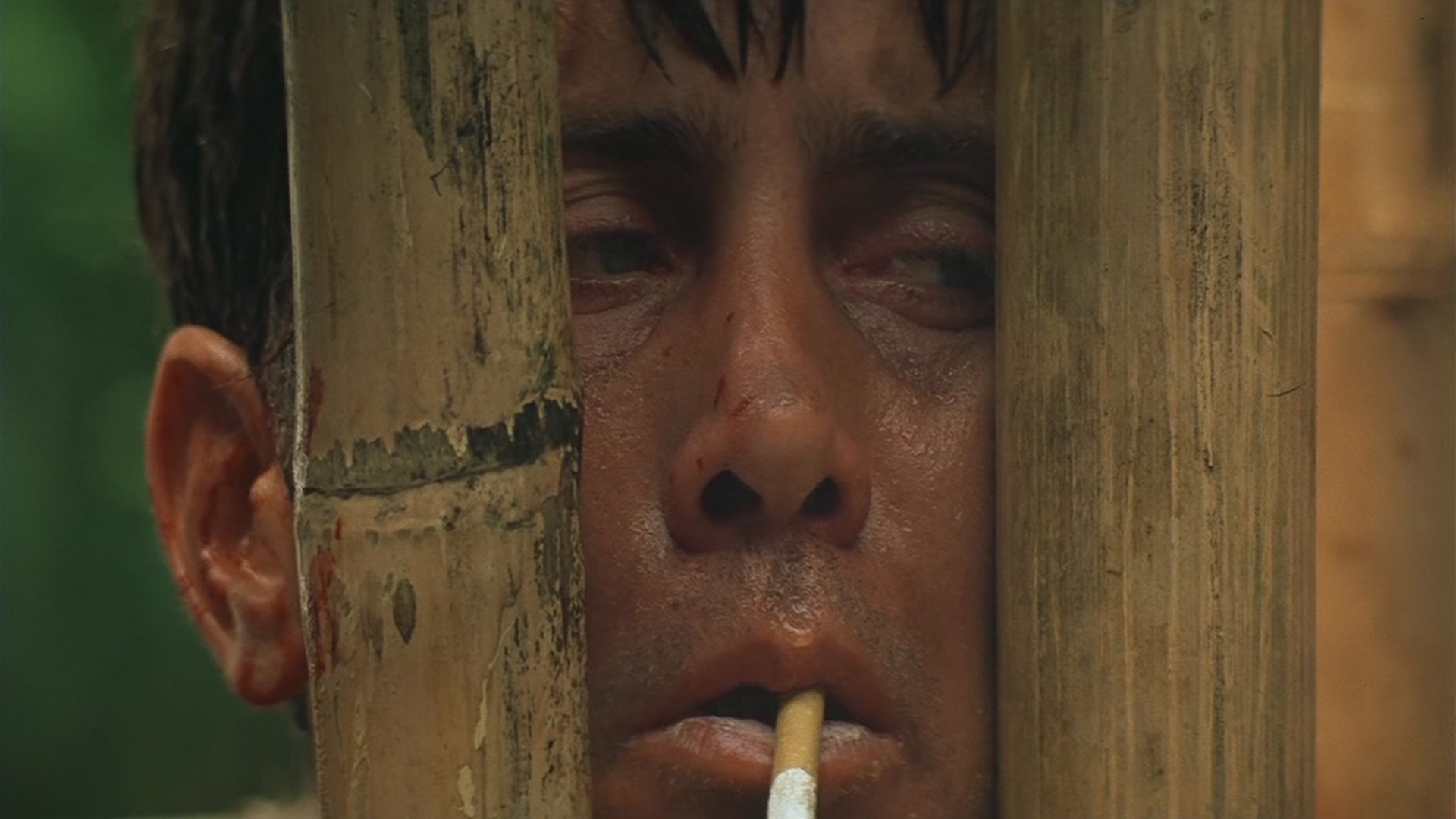
At one point "Kurtz" tells "Willard", his executioner, about his family and asks the other to tell his son about him and his beliefs.

That night while the encampment is celebrating the killing of a large water buffalo. "Captain Willard" goes on his mission:
To Terminate Kurtz With Extreme Prejudice!

"Captain Willard" enter's "Colonel Kurtz's" room and taking a machete kills him, but before."Kurtz" dies he utters:
THE HORROR! THE HORROR!

"Willard" walks out of "Kurtz's" quarters and the natives and the American soldiers realizing what he has done. Start to bow to him acknowledging he is now their leader, but "Willard" gets "Lance" and the two leave on the River Patrol Boat.
Steven Spielberg and His Cartoon

Steven Spielberg was born December 18, 1946 in Cincinnati, Ohio. Spielberg had been Directing short subjects and a few television show episodes since 1959, but it was a made for television motion picture from a story and screenplay by Richard Matheson, author of "The Shrinking Man" aka: "The Incredible Shrinking Man" and "I Am Legend", entitled "Duel" in 1971. That "Overnight" brought the young man into the big leagues of motion pictures.
On September 13, 1993, on Fox Kids Network, the first episode of a Cartoon Series premiered from Executive Producer Steven Spielberg. It was created by Tom Ruegger an animator,story board artist, writer, producer and director.
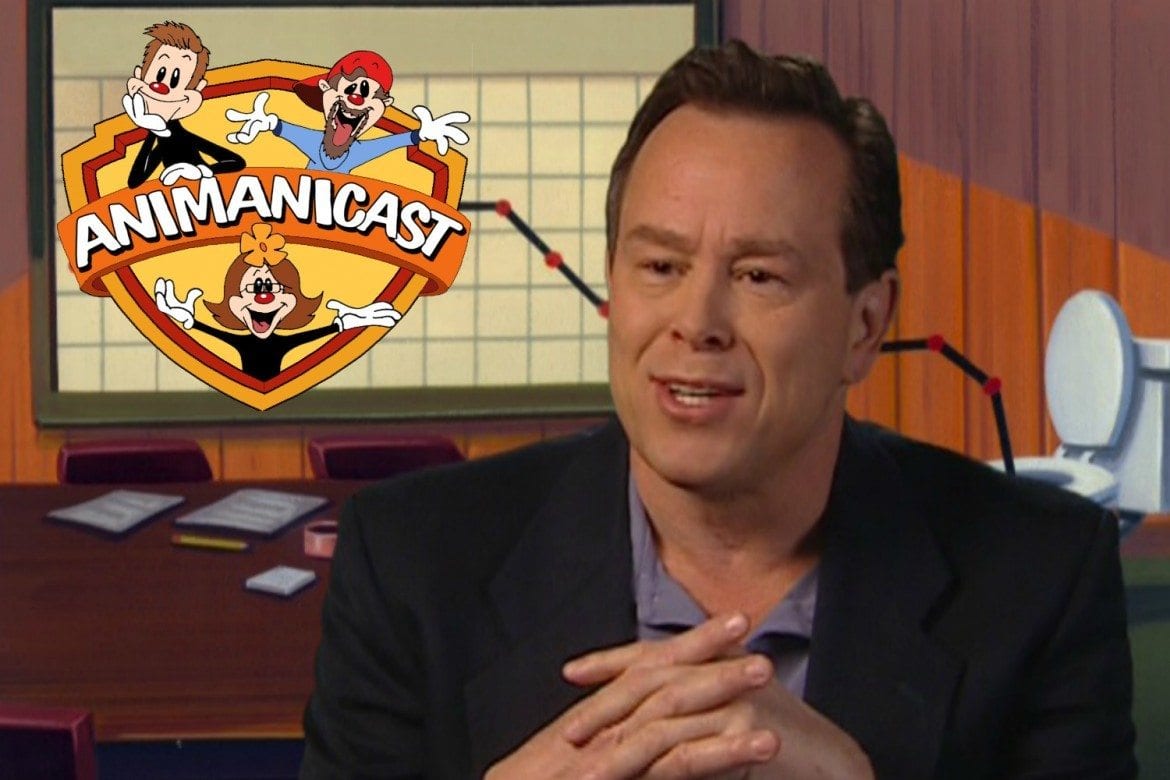
The program was known as either "Steven Spielberg Presents Animaniacs", or just "Animaniacs".

The main plots follow the two "Warner Brothers", "Yakko" and "Wakko" and "The Warner Sister Too", "Dot". Who when created caused mayhem on the studio lot. So they were locked away in the Water Tower, a studio trade mark. but every now and then escape.


Among the other popular characters were "The Good Feathers", gangster pigeons based upon the 1990 movie "Goodfellas", "Pinky and the Brain", laboratory mice who want to conqueror the world, "Dr. Otto Scratchansniff", the Studio psychiatrist and his assistant "Hello Nurse".

As my reader can tell the cartoons were meant not just for the kids watching the series but their parents too. Which brings me to Season One, Episode 20, first shown on October 11, 1993.
Each Cartoon Program is 22 minutes in length. Episode 20 had three different parts to it. This included a special opening segment parodying the opening sequence of the old television series "Alfred Hitchcock Presents".
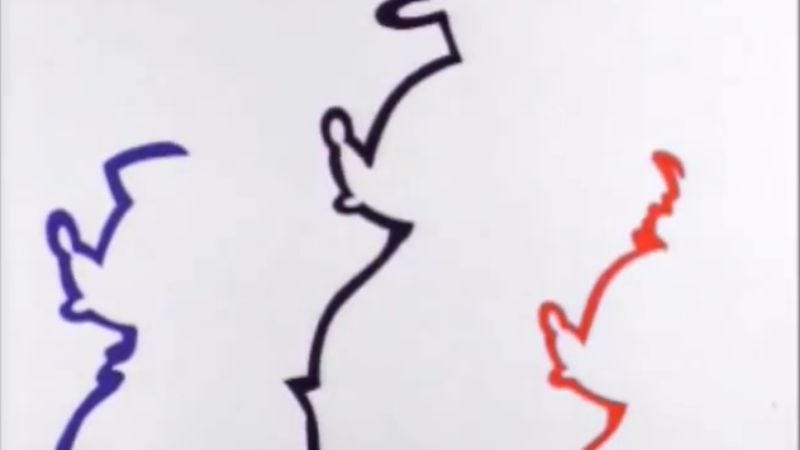
The third segment parodied Alfred Hitchcock's motion picture "The Birds". By having "The Good Feathers" hired as stunt birds in Alfred Hitchcock's "The Boids".. It is that second segment that I am interested in for this article.
The title of the segment starring "Yakko", "Wakko" and "Dot" was "Hearts of Twilight" and runs just short of 12 minutes.
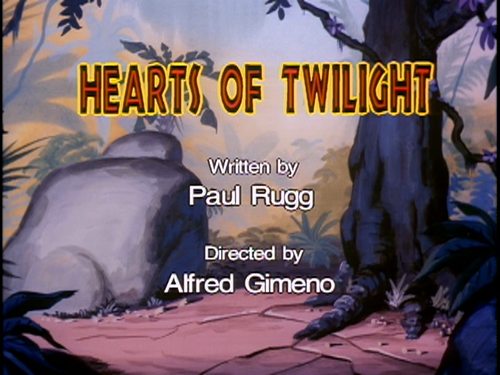
"The Warner's" are bought to the Office of "Thaddeus Plotz" the CEO of the Warner Brothers Studio.
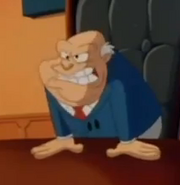
They are told that "Mr. Director" has flipped out and won't let anyone on to the sound stage."The Warner's" are given a mission to "Stop the Director" and as "Thaddeus Plotz" explains it. He is seen wearing an Army Officer's Uniform and speaking as if this is an covert operation.
In "Apocalypse Now" Francis Ford Coppola used the song "The End" by "The Doors" almost as a theme song. So of course a song was created for "Hearts of Twilight" sung to the tune of "The End".
The lyrics to "The End" open with:
This is the end
Beautiful friend
This is the end
My only friend
In "Hearts of Twilight" the above lyrics become:
"This is the beginning, the beginning of our story, the beginning"
"This is the middle, the middle of our story, the middle"
"This is the ending, the ending, the ending of our story, the ending"
As "Yakko", "Wakko" and "Dot" leave on their mission in a studio golf cart. You hear the voice of "Wakko" narrating the trip and a map shows them going all over the lot as they proceed to the Sound Stage in question. Also another voice sings the above lyrics at appropriate places in the story being viewed.
Arriving at the sound stage "The Warner's" are met by the Photojournalist outside. He is attempting to block their entry and is a follower of "Mr. Director".The character looks a lot like Dennis Hopper and sounds a lot like him. "The Warner's" are put in a cage as prisoners like Martin Sheen in "Apocalypse Now".
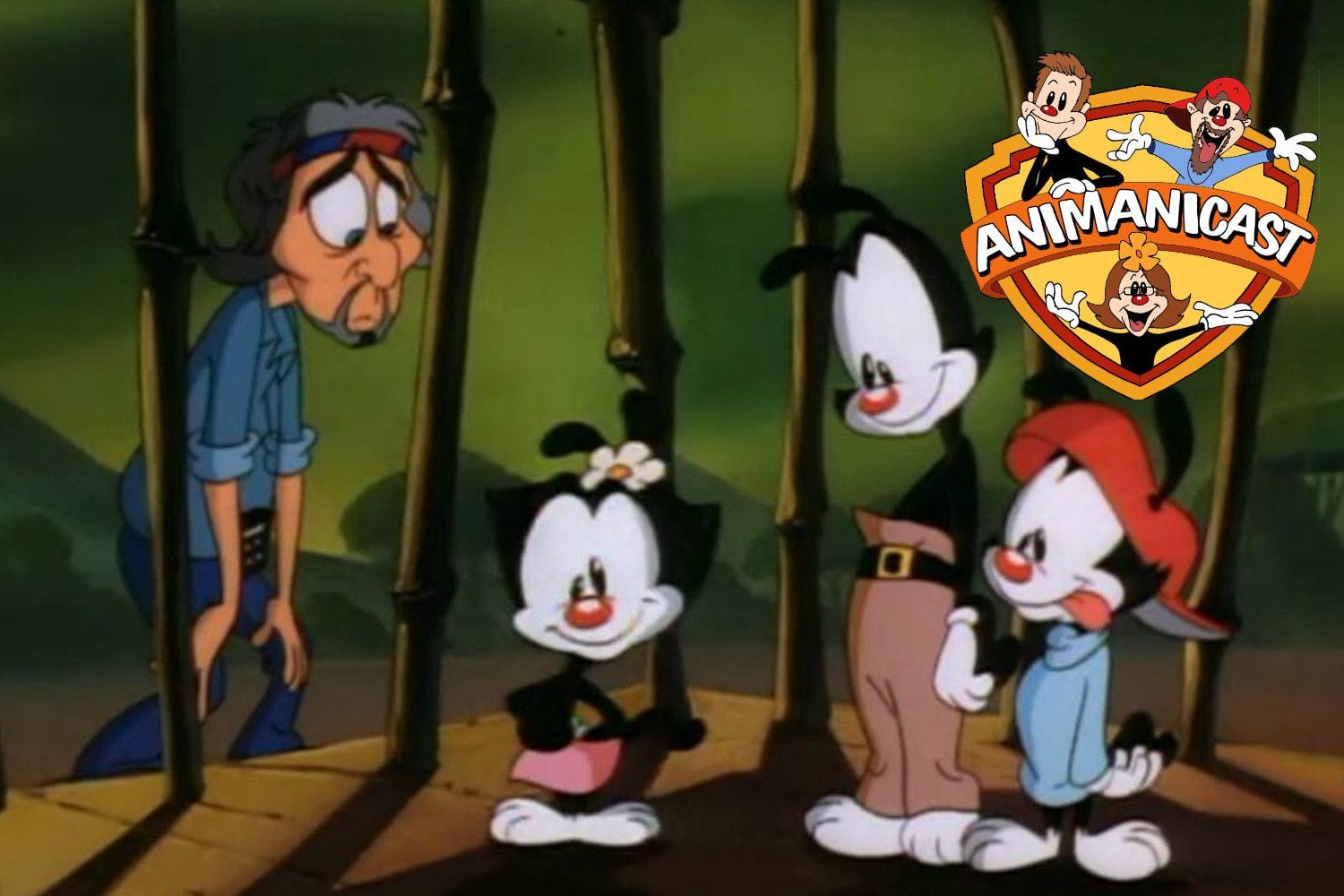
The three get out after they repeat the "Password" that the Photojournalist keeps repeating in a maniac monologue about "Mr. Director". Similar to the one given by Dennis Hopper to Martin Sheen about Marlon Brando. Then "Yakko", Wakko" and "Dot" enter the sound stage to confront "Mr. Director".
Normally "Mr. Director", a recurring character, looks like this:

He is an obvious parody of comedian/actor Jerry Lewis and speaks in a Lewis like voice. However, for "Hearts of Twilight", although speaking in the same voice, his physical appearance has been changed to Marlon Brando as "Colonel Kurtz". This includes wearing a purple outfit like Brando wore in some scenes in "Apocalypse Now",

The "Password" had been a variation of a Yiddish word and pronounced "Freunlaven".
"Freunlaven" becomes more than a password as the three "Warner's" drive the already crazy "Mr. Director" crazier. When the now truly crazy "Mr. Director", above, takes "Freunlaven" to the extreme. In a group of lines that has become a trivia classic and actually a major word search.
freunlaven! freunlaven! freunlaven! freunlaven!
freunlaven! flamiel! hoyl! how’d you…with the going…you were there…but here now…you are…for me to see…how’d you do…
Basically the word "Freunlaven" means "Nice Lady". A line that was associated with Jetty Lewis' comedy acts and used by "Mr. Director" speaking to "The Warner's" in any other cartoon, but this one.

"The Warner's" with their mission completed get into the studio golf cart and leave the sound stage. As they do the trio run over the singer of the episode's version of "The Door's The End" a caricature of Jim Morrison.
At the time of this writing the following link will take my reader to "Hearts of Twilight":
https://www.watchcartoononline.io/animaniacs-season-1-episode-20-hearts-of-twilight-the-boids


No comments:
Post a Comment